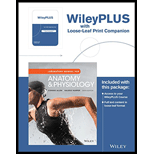
Laboratory Manual for Anatomy and Physiology, 6e Loose-Leaf Print Companion
6th Edition
ISBN: 9781119304142
Author: Connie Allen, Valerie Harper
Publisher: WILEY
expand_more
expand_more
format_list_bulleted
Question
Chapter 20, Problem 4.1BGL
Summary Introduction
To identify: The diencephalon structures in Fig 20.4 (a), (b), and (c).
Introduction: The brain is the most vital organ in the human body. The brain has three major regions namely, the cerebrum, brainstem, and cerebellum. The brain is the central processing unit of the body as most of the processes, such as voluntary to involuntary function and cognitive function, are carried out by the brain.
Expert Solution & Answer
Trending nowThis is a popular solution!

Chapter 20 Solutions
Laboratory Manual for Anatomy and Physiology, 6e Loose-Leaf Print Companion
Ch. 20 - Prob. 1.1BGLCh. 20 - Label the brain stem structures on Figure 20.2(a)...Ch. 20 - Prob. 3.1BGLCh. 20 - Label the diencephalon structures in Figure...Ch. 20 - Label the gray and white matter in Figure...Ch. 20 - Label the structures listed for Figure 20.6 and...Ch. 20 - Label the functional areas of the cortex in Figure...Ch. 20 - Observe the cranial meninges in Figure 20.9(a).
Ch. 20 - Label the structures in Figure 20.9(b).
Ch. 20 - Label the structures in Figure 20.10(a), (b), and...
Ch. 20 -
______________________________________
Ch. 20 -
______________________________________
Ch. 20 -
______________________________________
Ch. 20 -
______________________________________
Ch. 20 -
______________________________________
Ch. 20 -
______________________________________
Ch. 20 -
______________________________________
Ch. 20 -
______________________________________
Ch. 20 -
______________________________________
Ch. 20 -
______________________________________
Ch. 20 -
______________________________________
Ch. 20 -
______________________________________
Ch. 20 -
______________________________________
Ch. 20 -
______________________________________
Ch. 20 -
_______________
Ch. 20 -
______________________________________
Ch. 20 - Prob. 17BSCh. 20 -
______________________________________
Ch. 20 -
______________________________________
Ch. 20 -
______________________________________
Ch. 20 -
______________________________________
Ch. 20 -
______________________________________
Ch. 20 - _______________ Contains vital centers that...Ch. 20 - _______________ Smoothes and coordinates skilled...Ch. 20 - Prob. 3FBRCh. 20 - _______________ Controls and integrates the...Ch. 20 - _______________ Interprets sensory input, controls...Ch. 20 - _______________ Helps control breathing; conducts...Ch. 20 - _______________ Relays all sensory input to the...Ch. 20 - _______________ Coordinates visual and auditory...Ch. 20 - _______________ Coordinates gross, automatic...Ch. 20 - _______________ White fiber tracts communicating...Ch. 20 - The sites of CSF formation are the...Ch. 20 - special tiny capillaries located in the walls of...Ch. 20 - special tiny capillaries located in the walls of...Ch. 20 - special tiny capillaries located in the walls of...Ch. 20 - Prob. 5FCFCh. 20 - The two lateral ventricles are separated by a thin...Ch. 20 - CSF flows by cilia movement from the two lateral...Ch. 20 - Prob. 8FCFCh. 20 - Prob. 9FCFCh. 20 - CSF continues to flow into the inner part of the...Ch. 20 - CSF continues to flow into the inner part of the...Ch. 20 - Because CSF is continually being made at the rate...Ch. 20 - The venous sinus that overlies the brain...Ch. 20 -
___________________________________________
Ch. 20 -
___________________________________________
Ch. 20 -
___________________________________________
Ch. 20 -
___________________________________________
Ch. 20 -
___________________________________________
Ch. 20 -
___________________________________________
Ch. 20 -
___________________________________________
Ch. 20 -
___________________________________________
Ch. 20 -
___________________________________________
Ch. 20 -
___________________________________________
Ch. 20 -
___________________________________________
Ch. 20 -
___________________________________________
Ch. 20 -
___________________________________________
Ch. 20 -
___________________________________________
Ch. 20 -
___________________________________________
Ch. 20 -
______________________________________
Ch. 20 -
_______________________________________
Ch. 20 -
_______________________________________
Ch. 20 -
_______________________________________
Ch. 20 - Prob. 20UYK
Knowledge Booster
Learn more about
Need a deep-dive on the concept behind this application? Look no further. Learn more about this topic, biology and related others by exploring similar questions and additional content below.Recommended textbooks for you
 Human Anatomy & Physiology (11th Edition)BiologyISBN:9780134580999Author:Elaine N. Marieb, Katja N. HoehnPublisher:PEARSON
Human Anatomy & Physiology (11th Edition)BiologyISBN:9780134580999Author:Elaine N. Marieb, Katja N. HoehnPublisher:PEARSON Biology 2eBiologyISBN:9781947172517Author:Matthew Douglas, Jung Choi, Mary Ann ClarkPublisher:OpenStax
Biology 2eBiologyISBN:9781947172517Author:Matthew Douglas, Jung Choi, Mary Ann ClarkPublisher:OpenStax Anatomy & PhysiologyBiologyISBN:9781259398629Author:McKinley, Michael P., O'loughlin, Valerie Dean, Bidle, Theresa StouterPublisher:Mcgraw Hill Education,
Anatomy & PhysiologyBiologyISBN:9781259398629Author:McKinley, Michael P., O'loughlin, Valerie Dean, Bidle, Theresa StouterPublisher:Mcgraw Hill Education, Molecular Biology of the Cell (Sixth Edition)BiologyISBN:9780815344322Author:Bruce Alberts, Alexander D. Johnson, Julian Lewis, David Morgan, Martin Raff, Keith Roberts, Peter WalterPublisher:W. W. Norton & Company
Molecular Biology of the Cell (Sixth Edition)BiologyISBN:9780815344322Author:Bruce Alberts, Alexander D. Johnson, Julian Lewis, David Morgan, Martin Raff, Keith Roberts, Peter WalterPublisher:W. W. Norton & Company Laboratory Manual For Human Anatomy & PhysiologyBiologyISBN:9781260159363Author:Martin, Terry R., Prentice-craver, CynthiaPublisher:McGraw-Hill Publishing Co.
Laboratory Manual For Human Anatomy & PhysiologyBiologyISBN:9781260159363Author:Martin, Terry R., Prentice-craver, CynthiaPublisher:McGraw-Hill Publishing Co. Inquiry Into Life (16th Edition)BiologyISBN:9781260231700Author:Sylvia S. Mader, Michael WindelspechtPublisher:McGraw Hill Education
Inquiry Into Life (16th Edition)BiologyISBN:9781260231700Author:Sylvia S. Mader, Michael WindelspechtPublisher:McGraw Hill Education

Human Anatomy & Physiology (11th Edition)
Biology
ISBN:9780134580999
Author:Elaine N. Marieb, Katja N. Hoehn
Publisher:PEARSON

Biology 2e
Biology
ISBN:9781947172517
Author:Matthew Douglas, Jung Choi, Mary Ann Clark
Publisher:OpenStax

Anatomy & Physiology
Biology
ISBN:9781259398629
Author:McKinley, Michael P., O'loughlin, Valerie Dean, Bidle, Theresa Stouter
Publisher:Mcgraw Hill Education,

Molecular Biology of the Cell (Sixth Edition)
Biology
ISBN:9780815344322
Author:Bruce Alberts, Alexander D. Johnson, Julian Lewis, David Morgan, Martin Raff, Keith Roberts, Peter Walter
Publisher:W. W. Norton & Company

Laboratory Manual For Human Anatomy & Physiology
Biology
ISBN:9781260159363
Author:Martin, Terry R., Prentice-craver, Cynthia
Publisher:McGraw-Hill Publishing Co.

Inquiry Into Life (16th Edition)
Biology
ISBN:9781260231700
Author:Sylvia S. Mader, Michael Windelspecht
Publisher:McGraw Hill Education
Nervous System - Get to know our nervous system a bit closer, how does it works? | Neurology; Author: FreeMedEducation;https://www.youtube.com/watch?v=6O-0CVAgaEM;License: Standard youtube license